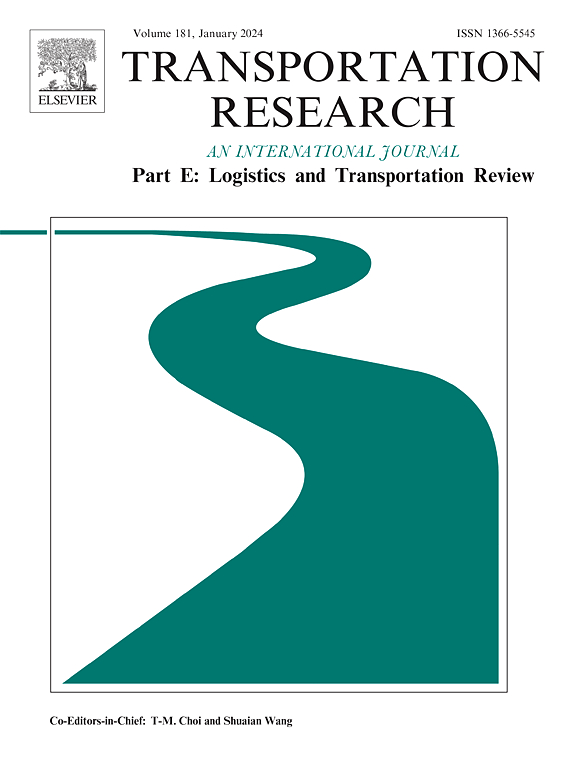数字服务能力的竞争策略:自我发展vs.合作
IF 8.3
1区 工程技术
Q1 ECONOMICS
Transportation Research Part E-Logistics and Transportation Review
Pub Date : 2025-07-21
DOI:10.1016/j.tre.2025.104291
引用次数: 0
摘要
我们研究了两家竞争的数字公司在智能产品服务系统中部署数字服务能力所产生的各种竞争模式,并分析了数字服务增值、智能产品和数字服务之间的一致性对竞争对手运营的影响。构建博弈论竞争模型,推导出数字企业数字服务能力的最优部署策略,并确定最优数字服务水平和定价策略。根据特定竞争模式下的子博弈完全均衡结果,我们发现即使一方的数字服务能力较弱,其数字公司在盈利能力方面仍然具有超越竞争对手的潜力。此外,数字服务提供的附加值的增加可能会削弱数字公司的盈利能力。同样,智能产品和数字服务之间的高度一致性可能对数字公司有害。此外,我们的分析显示,当两个竞争对手的数字服务能力都很强时,其中一个数字公司将偏离对称的数字服务能力部署策略,导致一个公司内部投资发展数字服务能力,而另一个公司与外部供应商合作的不对称均衡。相反,当数字服务能力较弱时,两家竞争的数字公司都选择内部投资来部署数字服务能力。然而,这种对称均衡策略最终使两家数字公司陷入囚徒困境。本文章由计算机程序翻译,如有差异,请以英文原文为准。
Competitive strategies in digital service capability: Self-Development vs. Cooperation
We examine various competition modes arising from the deployment of the digital service capabilities by two competing digital companies in smart product service systems, and analyze the effects of digital service value-addition, the alignment between smart products and digital services on the operations of rival parties. We construct game-theoretic competition models to derive the optimal deployment strategy for digital companies’ digital service capabilities, as well as to determine the optimal digital service level and pricing strategy. According to the sub-game perfect equilibrium outcomes derived from a specific competition mode, our findings uncover that even if a party’s digital service capability is weaker, its digital company still possesses the potential to outperform its rival in terms of profitability. Additionally, an increase in value-addition offered by digital services can undermine digital companies’ profitability. Likewise, the heightened alignment between smart products and digital services can be detrimental to digital companies. Furthermore, our analysis unveils that when the digital service capabilities of both competitors are strong, one of the digital companies will deviate from the symmetrical digital service capability deployment strategy, resulting in an asymmetrical equilibrium in which one company invests internally to develop a digital service capability, while the other partners with an external provider. On the contrary, when the digital service capabilities are weak, both competing digital companies opt to invest internally to deploy the digital service capability. However, this symmetrical equilibrium strategy ultimately places both digital companies in a prisoner’s dilemma.
求助全文
通过发布文献求助,成功后即可免费获取论文全文。
去求助
来源期刊
CiteScore
16.20
自引率
16.00%
发文量
285
审稿时长
62 days
期刊介绍:
Transportation Research Part E: Logistics and Transportation Review is a reputable journal that publishes high-quality articles covering a wide range of topics in the field of logistics and transportation research. The journal welcomes submissions on various subjects, including transport economics, transport infrastructure and investment appraisal, evaluation of public policies related to transportation, empirical and analytical studies of logistics management practices and performance, logistics and operations models, and logistics and supply chain management.
Part E aims to provide informative and well-researched articles that contribute to the understanding and advancement of the field. The content of the journal is complementary to other prestigious journals in transportation research, such as Transportation Research Part A: Policy and Practice, Part B: Methodological, Part C: Emerging Technologies, Part D: Transport and Environment, and Part F: Traffic Psychology and Behaviour. Together, these journals form a comprehensive and cohesive reference for current research in transportation science.

 求助内容:
求助内容: 应助结果提醒方式:
应助结果提醒方式:


